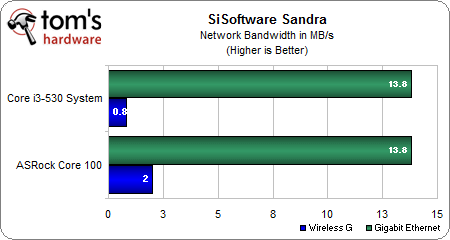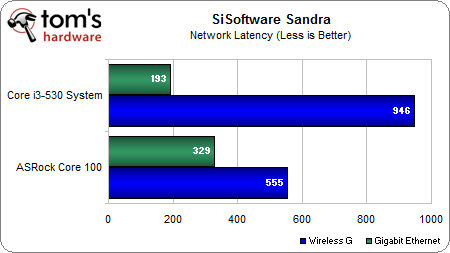ASRock Core 100HT-BD Home Theater PC
ASRock delivers a Wii-sized home theater PC (HTPC) with a powerful Core i3 CPU, Intel HD Graphics, and a Blu-ray drive. We put the Core 100HT-BD system through a number of tasks to see how its performance compares to a desktop-based home theater PC.
WAN And WiFi Network Benchmarks
The Core 100HT-BD uses the Realtek RTL8111E chipset for gigabit Ethernet and the Atheros AR9287-BL1A card for wireless connectivity. The Core i3-530 system we put together uses the Realtek RTL8111D chipset for Gigabit Ethernet and a D-link WDA-2320 card for wireless networking. Let’s see how network bandwidth compares using SiSoft Sandra’s Network benchmarks:
The gigabit Ethernet results are tied at 13.8 MB/s, which makes sense because both motherboards use virtually identical Realtek chipsets (and are likely bottlenecked by their storage subsystems, as well).
However, the ASRock Core 100HT-BD shows strong wireless performance compared to the desktop D-link WDA-2320 card, which is somewhat surprising, since we are testing with a wireless router running the 802.11g standard. The Core 100HT-BD boasts excellent relative performance that is very noticeable during Internet use. This demonstrates how the ASRock system’s Atheros AR9287-BL1A wireless card/dual-antennae combo is a good mix.
The network latency is slightly better on the desktop system, but the Core 100HT-BD demonstrates much better wireless latency.
Get Tom's Hardware's best news and in-depth reviews, straight to your inbox.
Current page: WAN And WiFi Network Benchmarks
Prev Page HD Video Playback Benchmarks Next Page Overclocking BenchmarksDon Woligroski was a former senior hardware editor for Tom's Hardware. He has covered a wide range of PC hardware topics, including CPUs, GPUs, system building, and emerging technologies.
-
Stardude82 Certainly beats a Zino, but the price puts it in the class of a Mac Mini. An M600 + HD4200 system would be interesting for a HTPC like this.Reply -
DeZenT Asrock also puts alot of focus on the possibility of streaming true Bluray sound. One thing, that all other pre-buildt htpc lackReply -
liquidsnake718 Well this is great and can do alot more than a regulr media player, but id prefer the ASUS OPLAY! and have a standalone media player while I also have a supercomputer or a monster PC and a console gaming system......Reply -
amgsoft I'am testing one at home. Excellent piece of hardware for multimedia and TV center. This HTPC is much faster to boot and shutdown (S3 sleep mode) then the traditional DVB-T boxes i had previously at home (2-3 sec startup, 9-11 sec shutdown). All I needed to do was to buy a DVB-T USB dongle (terratec). In S3 it uses very low power (less then 1W according to the reviews on the internet). I'am using for watching the DVB-T, dvd's, playing music, showing photo. Its performance is more then adequate, so I cannot see any reason for overclocking the unit. The heat comming out of the unit is very acceptable, the noise is hardly, if at all, noticeable.Reply
The only limitation is the angle of the IR remote. The angle for remotelly controlling the unit from your living room is a bit narrow for home use and I hope that they will consider to provide an external IR receiver later.
Regarding the price, I was trying to find a cheaper unit with same specs and same look and size, but I was not able to find any. Dell has a PC which is a bit smaller (a bit bigger then wii) however it is not a htpc unit. You can build a sligthly cheaper one. It will be larger, will need a larger power supply, the case will like a traditional pc which you don't want in your living room, and at the end of the day you will end up with something which has cost you more money. In my mind its a very good hardware piece and worth to consider if you want a home media center in you living room. -
jestersage Where I am, it's mighty expensive. But what I like about this article and the Core100HT-BD is that it inspires me to put together a similarly small and 'cute' system.Reply
I'm thinking along the lines of an e3300 and G31 chipset with a 200w or 300w mATX PSU (how I'd love to get my hands on a Silverstone 300w mATX unit from the SG05!).
Without the powersupply, the unit will cost about USD250 here. With a decent 80plus mATX PSU, the cost goes beyond the USD320 mark.
It won't play blu-ray but everything else would run better than, say, an Atom (even the ION variants). It would be twice as tall, almost twice large and a tad deeper, true, but it would have room for a half-height PCIE video card (ahem, HD5570) upgrade.
One bit of constructive feedback for Don: why use a 650W PSU on the comparison unit? Wouldn't a 380w or even 300w PSU be sufficient - not to mention place the power draw closer to the center of the efficiency curve? -
rwpritchett A step in the right direction. I'd like to see more pre-built HTPC's like this but with better styling and more expansion options. A slot load drive would also be great.Reply
I wish they would make the parts available so us DIY'ers can build our own like this. -
bunz_of_steel good review and attention to the real needs of an htpc. size, heat, noise and video performance. The price tag is just yuk! I would like to see how this would compare to a geek dude building their own and see how it fares... :)Reply

